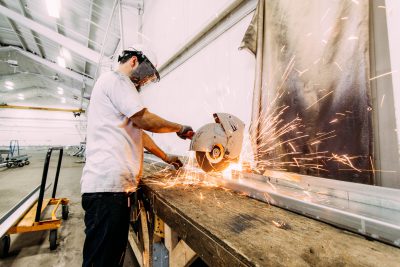The manufacturing industry processes raw materials and materials into semi-finished goods and products. This can vary from hinges and metal machines, from computer parts to buses, and much more. As such, the sector plays a crucial role in the circularity of the Dutch economy. The manufacturing industry in Europe can save up to €550 billion a year on raw materials if it is organised according to circular principles. Closing raw material cycles is particularly important for the manufacturing industry, because many companies in this sector are dependent on certain critical raw materials.
The manufacturing industry is a diverse sector in which machines, metal products, means of transport, electronics, plastics processing and textiles, among others, are manufactured. In this article we will explore the opportunities and barriers of a transition to closed material flows in this sector.

Figure 1: Many manufacturing companies are located in the southern and eastern Netherlands.
Opportunities
While opportunities are everywhere in the manufacturing industry, there are three strategies on which many entrepreneurs focus:
- High quality recycling, so that there is no outflow of materials, including critical raw materials;
- Optimising use, so that products can be used for longer;
- Developing new business models, so that the focus of propositions is not on the product, but on the function.
Numerous companies in the manufacturing industry are working on this, of which we highlight three examples below for illustrative purposes.
Black Bear wins Carbon Black from tyres
More than a billion car tyres are discarded every year. Many of these tyres are burned. The company Black Bear has developed a process in which a valuable component, black sludge, can be recovered during the recycling of the car tires. In this way, the company saves CO2 emissions, generates energy and can produce sustainable black for the tire, rubber, plastic and paint market (Black Bear, 2019).
Companies that want to find out what savings can be made on the use of raw materials and materials during the production process, can use one of the many tools that have been developed for this purpose. Versnellingshuis CE has made an overview of 13 tools to measure circularity (in Dutch).
Remade in Holland gives engines a new life
The remanufacturing of electric motors, pumps, gearboxes and related products is Remade’s core business in Holland. Many manufacturers who lease or buy back products often want to have parts overhauled and remanufactured before they are used again. In other cases, the manufacturer can no longer order an original motor or pump and is dependent on the remanufacturing of old models. The service of Remade in Holland also encourages companies to make their products of better quality so that after an overhaul the product can be reused (Remade in Holland, 2019).
Companies that want to check their dependence on certain raw materials can make use of the raw materials scan developed on behalf of the Ministry of Economic Affairs: www.grondstoffenscanner.nl.
Pallets as a service
The pallet company IPP shows that even for a bulk product such as pallets, circularity can be lucrative. More than twenty years ago, the family business made the step towards a circular business model. IPP decided to no longer produce and sell pallets for one-off use, but to keep them in its own possession. As a result, the customer only pays for the use and it is beneficial for IPP to quickly re-install the pallets and repair them if necessary. In addition to pooling pallets, IPP also takes care of responsible production and processing of rejected pallets. In this way almost all aspects of the company are circular (IPP, 2019).
Companies that want to redesign their products, services and business models to be circular can start with the CIRCO training courses.
Economic and ecological profit
The manufacturing industry is so diverse that it is difficult to calculate the economic benefits of circularity in all its subsectors. The Ellen MacArthur Foundation calculated that closing cycles would reduce raw material procurement costs by 19-23%. On an annual basis, this equates to savings of 460 to €550 billion (Ellen MacArthur Foundation, 2014). TNO calculated specifically for the metal industry in the Netherlands that this sector could earn around €575 million annually by focusing more firmly on circularity. In addition, this would structurally lead to more than 10 thousand new jobs (TNO, 2013).
Little has been published about the ecological gains that can be made if the manufacturing industry specifically becomes circular. However, it is known that the energy sector and process industry, with 47 and 35 billion kg of CO2 respectively, are the largest emitters of the Dutch economy. A large part of their energy and materials are used by the manufacturing industry, so making those production processes circular will yield significant environmental gains (RIVM, 2018).
The barriers
Despite the many opportunities offered by a circular manufacturing industry, there are three factors hindering its development: suitable workers, financing, and the international market (Kaanen et al. 2018).
Suitable workers
An existing barrier that will become more acute in the transition to a circular economy is the shortage of technical personnel. At the moment, many companies in the manufacturing industry already have to look abroad for well-trained workers. In order to complete the transition to a circular economy, Dutch education must already anticipate upcoming developments. This means that students must be trained in critical, creative and problem-solving thinking, social, information and ICT skills, in addition to being able to collaborate, plan and organise. From this background, companies can often further train employees internally.
Funding
Offering new products or services is often associated with high investment costs in the manufacturing industry, which means that a certain purchase guarantee must exist for companies to be able to make these investments. Governments can play an important role in this by acting as launching customers or imposing certain circular requirements in the procurement process. Financiers can also contribute to this by going along with new business models and products that have not yet been proven.
International market
If a company wants to work circularly, other parties in the chain must always cooperate. The internationalisation of the value chain in the manufacturing industry makes this extra complicated. In the first instance, the European Union has a role to play in this, which can facilitate circular developments in chains by unleashing the circular transition in all its countries.
Solutions
To overcome these barriers, the manufacturing industry in the Netherlands has set up the “Circular Manufacturing Industry” programme. This is the transition team of the government-wide Circular Economy Programme. Check the website for more information: www.circulairemaakindustrie.nl


